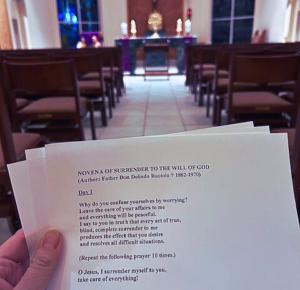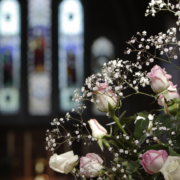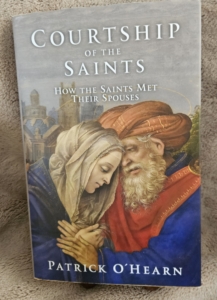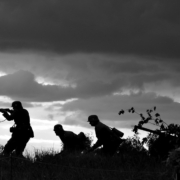We Are All Pilgrims
Stand at the crossroads and look; ask for the ancient paths, ask where the good way is, and walk in it, and you will find rest for your souls. (Jeremiah 6:16)
In 2016, something amazing happened to me. I was able to get two spots on the Catholic Channel’s lottery for a pilgrimage to the Holy Land. I could hardly believe this dream might come true. My husband was reluctant at first, but one look at the itinerary and he was all in. “These are all real places that still exist?” he asked. My assurance they are was all he needed.
A Life-Changing Pilgrimage
I always tell people that a pilgrimage, particularly to the Holy Land, is life-changing. For me, this journey facilitated multiple changes. From meeting a group of women who would become my closest friends, to discovering more about myself and God’s plan for me, to going from a writer to speaker and pilgrimage leader myself were things I never imagined would happen. Since that trip, I have gone on pilgrimage to the Holy Land once more as a pilgrim and once as a leader (my second and third chances at leading have been on hold since the October 6 massacre). I have organized and led two pilgrimages on El Camino (one for myself and two friends and one for thirty-three pilgrims), one pilgrimage to Italy, and several “local” pilgrimages. Next month, I’m taking 43 pilgrims to France!
Ever since that first pilgrimage, I have felt like a different person. No that’s not quite right. I have become a different person, someone whose life has been turned in the right direction. Where God always had a place in my life — one that was dictated by my own needs and schedule — He now occupies every space of my life, and I’m constantly turning to Him to make decisions about everything from what I eat to what I write.

We Are All Pilgrims
What a wonderful gift Pope Francis gave us in this Jubilee Year of 2025. He has proclaimed each and every one of us a Pilgrim of Hope. The Holy Father has declared this to be a year of hope and patience as we await our call home to Christ. “This interplay of hope and patience makes us see clearly that the Christian life is a journey calling for moments of greater intensity to encourage and sustain hope as the constant companion that guides our steps towards the goal of our encounter with the Lord Jesus” (Pope Francis, Bull Of Indiction Of The Ordinary Jubilee Of The Year 2025, emphasis original). We are all pilgrims on this journey from birth to Heaven.
The Holy Father goes on to say, “Pilgrimage is of course a fundamental element of every Jubilee event. Setting out on a journey is traditionally associated with our human quest for meaning in life.” Pope Francis recommends that pilgrims travel to Rome and other places to walk through the Holy Doors, which are only open during the Year of Jubilee. However, you don’t have to travel far from home to experience a true pilgrimage!
The Pilgrimage of Life
While I’d love to have all of you join me on a pilgrimage of a lifetime, I urge you to think both smaller and longer when you consider the number one pilgrimage we all make. Our entire life is a faith journey, a pilgrimage, at times as glorious as the Sistine Chapel and then as arduous as El Camino. We are to travel this lifelong pilgrimage in the same manner Pope Francis encourages a pilgrimage abroad: as pilgrims “contemplating the beauty of creation and masterpieces of art, we learn to treasure the richness of different experiences and cultures, and are inspired to lift up that beauty, in prayer, to God, in thanksgiving for his wondrous works.” We are to see the beauty and presence of God in everything and everyone we encounter.
Like any pilgrimage, we all approach this lifetime pilgrimage with a mix of trepidation, expectation, and jubilation. There is so much to discover at each turn, so much growing and maturing to do, not just in age but in faith. Just like on the walk through Rome, we can easily become lost, tempted to follow the crowd, overwhelmed by the sights and sounds around us, and exhausted at the end of each day. Life is a continuous passage with tunnels, bridges, alleyways, cobblestones, and dirt paths. We must follow the road map that Jesus and the Church have given us and walk through this life with prayer, humility, and hope.

Life as Pilgrimage
Pope Francis tells us that, in this Jubilee Year, we are to desire peace and look to the future with hope that “entails having enthusiasm for life and a readiness to share it” so that we may “be tangible signs of hope for those of our brothers and sisters.” To do this, we must be able to follow in the footsteps of Christ, walking not just our path, but His. We are to share the Good News with the world, expressing our hope in the Risen Lord and His teachings. This is not easy. Jesus told us, “Whoever wishes to come after me must deny himself, take up his cross, and follow me” (Matthew 16:25). He’s warning us that the walk is not always easy. There are hills to climb, rivers to cross, and heavy loads to carry, but those are what lead us to our final destination.
This year, allow yourself to fully realize what it means to be a pilgrim, but even more, a Pilgrim of Hope. Begin your journey today with small steps. Take a walk in the garden while you give praise to God for the bright green stems pushing through the earth. Walk through one of the Gospels, focusing on the times Jesus taught us to follow him, from the call of Peter to Jesus telling us, “you know the way” (John 14:4). Begin a new path of prayer at intervals throughout your day to give thanks and praise and asses your journey.
How ever you choose to walk your pilgrimage, allow yourself to be open to whatever happens along the way. I always tell my pilgrims that the number one rule to being a pilgrim is to be flexible and remain open to the Holy Spirit. Always keep your eye on the shining cathedral on the hill and your heart filled with hope.
We see in these swift and skillful travelers a symbol of our life, which seeks to be a pilgrimage and a passage on this earth for the way of heaven. – Pope Paul VI
Copyright 2025 Amy Schisler
Photos copyright 2025 Amy Schisler, all rights reserved.





 2025 by Margaret King Zacharias
2025 by Margaret King Zacharias
 Photo by Eugenia Remark: https://www.pexels.com/photo/decorated-cards-golden-plate-and-ring-in-box-14784845/
Photo by Eugenia Remark: https://www.pexels.com/photo/decorated-cards-golden-plate-and-ring-in-box-14784845/ into the 21st Century. They shaped the church in some way through their sacrifice and devotion to one another and to their families by making the prayer their foundation and God the center of their lives.
into the 21st Century. They shaped the church in some way through their sacrifice and devotion to one another and to their families by making the prayer their foundation and God the center of their lives.


